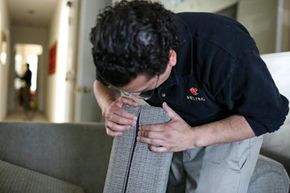Locking your doors and setting the alarm when you go to bed at night may not be enough to protect you from bloodthirsty marauders. When you lay your sleepy head on that nice, soft pillow, your bed, bedroom and even your body may be harboring insect invaders that will feast on you in your sleep, leaving the ravages of their filthy bites behind to torment you with bumps, redness, and sometimes the real threat of disease.
The phrase "Sleep tight, and don't let the bedbugs bite" isn't a quaint artifact from a simpler time. It's real, and it's happening right now -- probably in a home or public building near you. Bedbug populations have been on the rise and on the move over the last decade. In the 1950s, the liberal use of the pesticide DDT almost eradicated them, but even then, small numbers were building up a tolerance against it and other measures developed since then to control household pests. The result is a super bedbug with a high tolerance for chemical pesticides and a powerful urge to take a bite out of you while your catching some Z's.
Advertisement
Although bedbugs are getting lots of press these days, they aren't the only threat. From hungry mosquitoes to thirsty fleas, there are lots of critters around that think your bedroom is a banquet hall when it comes to eating in style.
Advertisement






